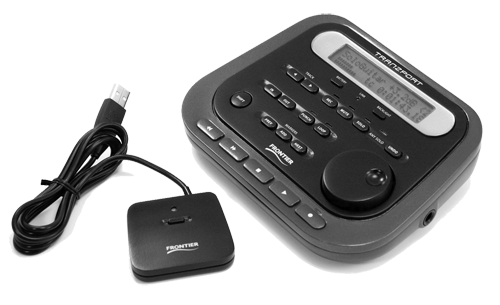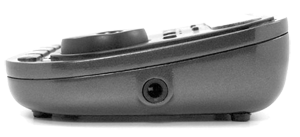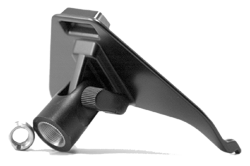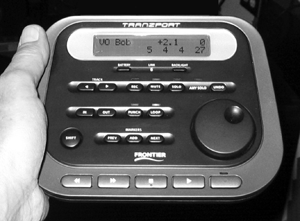
by Steve Cunningham
Every now and again a device comes along that makes you slap your forehead and exclaim “Why didn’t they think of this before?” Well, maybe not... but the little Tranzport wireless remote control for your computer audio editor certainly qualifies for a “dope slap” reaction.
The problem that Tranzport controller solves is a common one, especially for voiceover talent and production folks that record themselves solo. Instead of the hassle of running long keyboard and mouse cables into the recording booth, or even worse, having to hit the spacebar and then dash back in front of the microphone where you then try to settle down and read the copy, you could just carry the wireless Tranzport DAW controller into the booth with you, press the REC button, and read the copy.
The Tranzport comes to us from Frontier Design, a small company based in New Hampshire that has been building audio interfaces for the past ten years. More recently, Frontier Design has partnered with TASCAM, and has co-designed most of TASCAM’s USB and Firewire interface/control surface products, including the US-428 and FW-1884 products. These guys clearly know their stuff.
The TranzPort is a small, wireless workstation controller that works with Mac OSX (10.2.8 or higher) and Windows 2000 or XP (including Service Pack 2). It comes with a small USB transmitter and receiver, called the Bridge, which plugs into a USB port on your computer and lets the remote operate your editor from better than 30 feet away.
It’s bi-directional, which is to say that data flows both to and from your editor, allowing Tranzport to display track information on its backlit LCD screen.

INSTALLATION
The TranzPort’s installers, software components, and documentation are provided on a CD-ROM, and installing the Tranzport software driver under Windows couldn’t be simpler. The installer CD takes you through the process, and offers to install templates for Adobe Audition, Cubase, Nuendo, or Sonar as part of the process. Those of you who use Pro Tools, SAWStudio, Logic, or Acid will be glad to know that the Tranzport works with these and many others right out of the box. Along the way, Windows may ask you if you want to install this new WDM device, and the process will then require a restart. When you’re done, you’ll have a new icon in your tray that allows you to configure the Tranzport’s mode (see below). Mac OSX users will have an equally easy time installing the software, and the Tranzport icon will show up on the right side of the Finder’s menu bar.
Once that’s done, you should pop the four supplied AA batteries into the bottom of the Tranzport. Pressing the BATTERY button will show you the condition of the batteries in the display as a row of asterisks. The TranzPort runs only on batteries and doesn’t have an OFF button. It does, however, go into a low-power Sleep mode after some time has elapsed without any activity, and you can set that time period from one minute up to an hour by holding down the SHIFT key and pressing the BACKLIGHT button. Yes, the display has a backlight, which while somewhat dim, works well enough to illuminate the display in a cave like mine. Do be aware however, that the backlight will substantially reduce the lifespan of your batteries. But without it, you’ll get about 100 hours on a set of alkalines, and Frontier claims that the batteries will last you several years when the Tranzport is in sleep mode.
The Tranzport communicates with the Bridge via RF signals on 2.4GHz frequency. This is, of course, the same frequency as is used by WiFi, Bluetooth, many wireless phones, and microwave ovens, and these may reduce the distance over which the Tranzport will work. Frontier claims that the unit can work as much as 100 feet away from the remote, depending on physical orientation of the bridge, interference from other wireless devices like phones, and other factors. My experience is that it works at about the same range as does my wireless laptop, and moving or turning the Bridge can improve a weak signal (you can tell when it’s weak because the Link LED will flash).
It definitely works through walls, although like WiFi you may lose the signal going through multiple walls, or if there’s a metal cabinet between the Bridge and the Tranzport.
The Tranzport will appear as a MIDI input/output device within your editing software. It actually sends MIDI messages wirelessly to your software, and the control mode specifies which types of MIDI message it sends and receives depending on your editing software. Using the little Tranzport icon in your taskbar or menubar, you can set it to Tranzport Native, Pro Tools (HUI), or Cubase (Mackie Control). If the Tranzport’s installer included a dedicated plug-in for your editor (as it does for Audition), then starting the editor will automatically select the correct mode. Otherwise, you’re welcome to grab the little icon and make a selection yourself.
Most of the time simply starting up your editor will activate the Tranzport. In some cases the Tranzport and Bridge may have trouble finding one another, in which case you press the single button on the Bridge, then press SHIFT and BATTERY on the Tranzport, and the two will “bind” to one another. In any case, you want the Tranzport up, running, and in one of the three modes before you start your editor, so any templates necessary to run your editor get loaded properly.
 WORKING WIRELESSLY
WORKING WIRELESSLY
The TranzPort features a 2 by 20-character LCD screen. When you first open a project in your editor, the TranzPort activates itself in Track Mode, in which the unit’s LCD shows the name of the project’s first audio or aux track and its fader level and pan position, along with the editor’s current counter location. You can then use the TranzPort to step or scroll quickly through each of the project’s tracks and view their parameter values on the LCD screen. During playback, the LCD shows the mono or stereo level(s) for the currently selected track using a horizontal bar graph.
Below the Tranzport’s LCD screen are eighteen dual-function buttons and a data wheel, which offers multiple detents. Pressing and holding down an additional Shift button lets you toggle the buttons to perform their alternate functions. Button functions include basic transport (play, stop, rewind, fast-forward, record, return to start, go to end); record-enable, mute, and solo for the currently displayed track (and respective clear functions for all tracks), along with adding and stepping through markers in either direction. Other possible functions include activating or disabling auto-punching and global looping as well as creating in and out points for those functions, and multiple-level undo and redo (to a maximum of your software’s capabilities). Increment and decrement buttons let you step through all the tracks and buses in your project, and variously colored status LEDs show the current track’s record, mute, and solo status. An LED labeled Any Solo will flash when any track is soloed. Other LEDs light up when the editor’s auto-punch and memory-loop functions are active. Finally, a green Link LED lights to confirm the TranzPort is communicating successfully with the Bridge.
You can also use the TranzPort’s Shift and Stop buttons in Native Control mode as modifier keys for most of the other buttons to execute additional user-definable functions, meaning you can program some additional commands yourself if your software allows that. Using the TranzPort’s data wheel, you can scroll your editor’s current counter location forward or backward in time, scroll quickly through track displays (which is useful for projects that have large track counts), or adjust the playback level and pan for the currently selected track. In addition to the 18 dual-function buttons noted above, there are the aforementioned additional local-control buttons that check the TranzPort batteries’ strength and toggle the LCD’s backlight on and off.
Optional accessories for the TranzPort include a footswitch (for punching-in and -out by way of a 1/4-inch jack on the TranzPort’s right side), a mic-stand adapter, and a padded bag. You can purchase each item for $14.95 or the entire shootin’ match for about forty bucks. Do plan on getting the mic stand adapter, which is terminally slick and lets you put the thing right next to the copy stand and swivel it to avoid glare from overhead lighting.

WE ARE ROLLING
I used the TranzPort to remotely control Adobe Audition 1.5 on my PC, and Pro Tools on my Mac (in HUI mode). It was easy to work in Audition with the TranzPort. Setting markers, memory-cycle (loop) points, and auto-punch-in and auto-punch-out points on the fly was a breeze. The TranzPort’s ability to step sequentially through markers (in either direction) helped me find punch-in points quickly, and I also put the TranzPort’s Undo button to good use whenever I needed to nuke the last fluffed take. It was also great to be able to solo or mute any combination of tracks while recording or playing back, and then clear all solos or mutes afterward. And I was happy to see that the TranzPort reliably updated the counter in Audition after auto-returning to a stopped position... it didn’t need Audition’s transport to be rolling to see the correct location. The only significant omission in Audition is that the Tranzport can’t emulate either the Enter or Esc keys, so if you forget to arm a track before hitting Record, you’ll have to use your computer keyboard to agree that you screwed up. With luck, Adobe will fix this in Audition v2.0 (coming soon).
Fewer features worked in Pro Tools, in part due to the fact that Digidesign uses the HUI implementation developed by Mackie some years back. But all the basics are there as shown on the Tranzport’s front panel, as well as a few others like pressing SHIFT-STOP to dismiss the “no tracks are record-enabled, you moron” dialog box. And unlike some other controllers I’ve used in the past, the Tranzport never lost its connection to Pro Tools.
The TranzPort displays only signal levels that pass through the CPU and not those of inputs that are routed directly to outputs, as you’ll find in some “zero latency” monitoring modes. But the metering is accurate against those in the software, and having them is a Good Thing.
The TranzPort works best when recording one track at a time, because its LCD can display parameter values and levels for only a single track. Nevertheless, it’s convenient to have such a small device — check the picture where I’m holding it — with its functions screened right on the front panel. Some other controllers out there also don’t give you the bidirectional response, including the multi-segment level metering and record, mute, solo, auto-punch, and loop-status indicators, that the TranzPort provides.
The manual is on the CD as a PDF, or you can download it from Frontier’s website. While you’re on the site, I also suggest you visit their online forum and driver download sections. Frontier is good about posting updates and additional drivers, and the individual instructions that will help you with your specific editor are available as PDF files, so go get ‘em.
I’M KEEPING IT
The Tranzport is another one of those very well-thought-out products that qualifies as a must-have. At a retail price of $249 and a street price under two hundred simoleons, it solves a significant problem very well. I immediately recommended it to a prominent VO client’s WhisperRoom-equipped home studio (she voices for ESPN and Lifetime), and she loves it. She stuck it on a mic stand in her booth and off she went.
And the more I use it, the more I like it. There’s nothing more frustrating than getting psyched to read copy, then having to turn around and use a computer keyboard to locate to a pickup point and get into record. With the Tranzport, it’s all right in front of me, and I can proceed “unencumbered by the thought process,” as they say.
After using for many weeks, the only complaint I can muster is that the Tranzport’s key commands vary depending on the software that it’s controlling. Switching back and forth between Pro Tools and Audition was confusing at first, but I understand that this is an issue with the software rather than with the Tranzport. Heck, the fact that it works with as many editors as it does out of the box is a minor miracle as far as I’m concerned.
There’s not much more I can tell you except that this unit will never see the inside of Frontier’s offices again — it’s staying here.
The Tranzport from Frontier Design carries a suggested list price in the US of $249. For more information, visit www.frontierdesign.com.
♦

